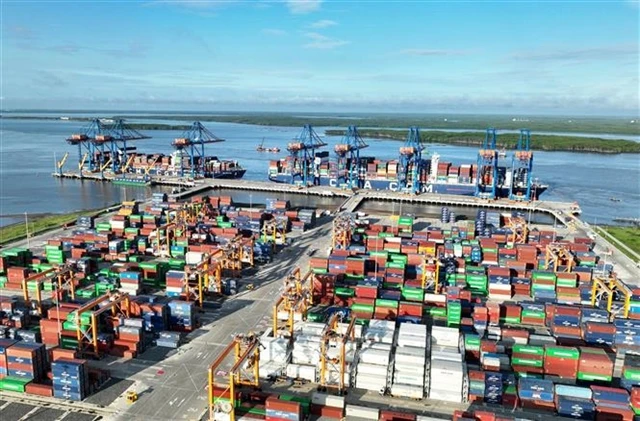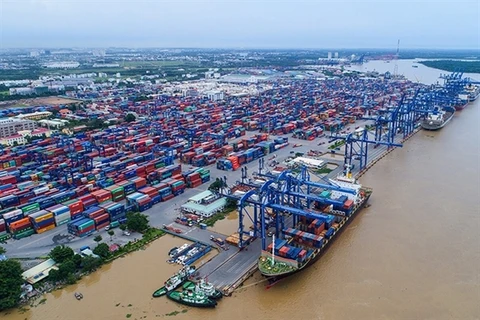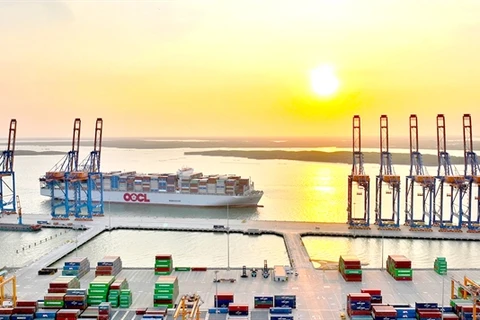
Hanoi (VNS/VNA) - The Vietnam Maritime Administration (VMA) said that sea freight rates have decreased recently, dropping by about 4% compared to the previous week.
The import and export of cargo through seaports grew dramatically, reaching the highest level in the past five years.
VTC News reported that in the first seven months of 2024, the volume of goods passing through Vietnamese seaports is estimated at 501.117 million tonnes, up 16% over the same period in 2023. Container cargo throughput is estimated at 16.902 million TEUs, a 21% rise over the same period.
"This is the highest growth rate in the past five years and is three times higher than the average growth rate in the past five years of 5.5%," a spokesman for the VMA said.
"The Cai Mep - Thi Vai deep water port area saw a 41% increase in container cargo, reaching 2.8 million TEUs compared to 2023. The Lach Huyen port area recorded 875,000 TEUs, an 87% increase over 2023."
By the end of July, sea freight rates had decreased across all routes, with the most significant drop being on the Asia-to-West Coast of the US route, where rates fell by 20 to 30 %. Other routes saw reductions of around 15 to 25%.
The reason for the decrease in freight rates is that shipping lines have increased their capacity and the pressure from the peak season has lessened, according to Vietnam National Television (VTV).
The VMA forecasts that this downward trend in freight rates will continue.
Previously, sea freight rates on major routes skyrocketed. At one point, the cost of shipping a container to Europe reached 4,000-5,000 USD, more than double the rates at the end of last year. Similarly, shipping rates to the US rose to 6,000-7,000 USD for a container.
Transport costs per container to closer destinations including China, Japan, the Republic of Korea and Southeast Asia increased by 1,000-2,000 USD.
According to the VMA sea freight rates are driven by market supply and demand dynamics. Given Vietnam's highly open economy, the country is a crucial link in the global supply chain and thus, shipping rates for goods through ports in Vietnam are subject to global trends.
Most Vietnamese import-export businesses do not directly pay shipping costs. However, the high freight rates have forced them to adjust their product prices, affecting their competitiveness in the market.
The VMA has noted that the rate of direct bookings for import-export goods made by Vietnamese businesses is low. Most transactions involve purchasing under CIF (Cost, Insurance, and Freight) terms and selling under FOB (Free on Board) terms, accounting for over 80%. Foreign partners typically handle the logistics contracts and pay the shipping costs.
The VMA added: "Vietnamese businesses that sign long-term shipping contracts with carriers are typically large companies with stable import-export volumes. Their long-term contracts are unaffected by market price fluctuations and freight rates remain stable throughout the contract duration.
"In contrast, smaller businesses with unstable cargo volumes will be directly affected by freight rate fluctuations.
"Additionally, some businesses do not sign contracts directly with shipping lines but work through forwarders as they provide additional services beyond transportation. As a result, smaller businesses often bear the additional freight rate difference."
Given this situation, the VMA advises Vietnamese enterprises to establish long-term contracts with international partners to mitigate the impact of freight rate fluctuations.
Industry associations should orient their members in production activities, serve as a central point for aggregating goods from businesses and negotiate stable, long-term shipping contracts with carriers to minimise the risk of price fluctuations./.






















